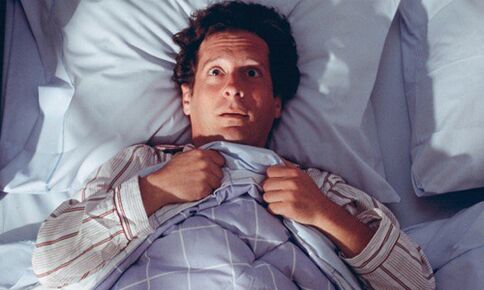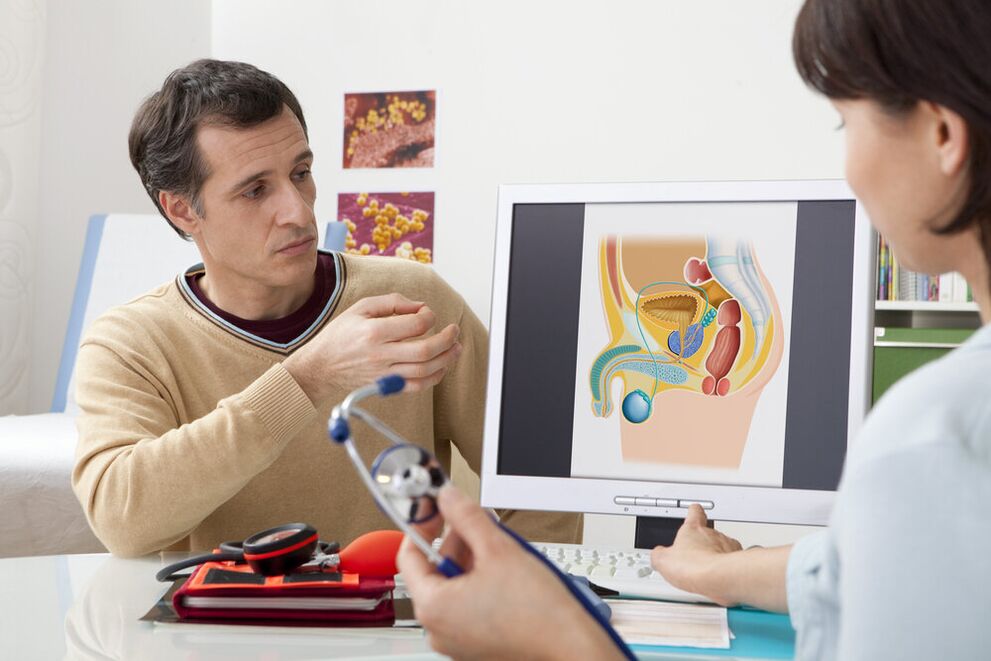Symptoms of prostatitis can be detected a few days after the onset of the disease. Depending on the age, the individual condition of the patient and other nuances, the disease can manifest itself clearly or proceed more calmly. Early access to a doctor and timely diagnosis guarantee the success of treatment, the absence of complications and relapse.

At-risk group
Inflammation of the prostate in men is diagnosed more and more frequently. The essence of the disease is simple. The gland, which is normally very small, enlarges dramatically, compressing the urinary tract and seminal ducts, causing problems with diuresis and normal ejaculation. There are many reasons for the appearance of the disease. The following patients are at risk:
- middle and older age;
- overweight and obesity;
- smokers and alcoholics;
- who have had diseases of the urogenital area (urethritis, cystitis, orchitis, balanitis, balanoposthitis, pyelonephritis);
- having an irregular sex life;
- practice coitus interruptus as the main means of contraception;
- under treatment with potent drugs (hormonal agents, antibiotics).

A few decades ago, symptoms of the disease were observed in middle-aged and elderly patients. But today, the disease is becoming more common in active young men who do not have any special health problems. Urologists distinguish 4 types of prostatitis: acute and chronic infectious, nonbacterial, prostatodynia.
The acute infectious form is more common in sexually active young men. The cause of the disease is bacteria that have entered the urethra and ureter. The source of infection is often the causative agents of sexually transmitted diseases: streptococci, gonococci, pale spirochetes, Trichomonas, chlamydia. In some cases, the bacteria enter the urethra from the rectum. This happens with insufficient hygiene of the genitals. In the absence of proper treatment, acute infectious prostatitis can become chronic. It is characterized by alternating periods of rest with a sudden deterioration in well-being. As the disease progresses, attacks become more frequent and last longer.
The onset of the disease: how to determine it
The first symptoms of prostatitis are easily confused with manifestations of other diseases. That is why patients do not rush to the doctor, taking painkillers or antipyretic drugs on their own. One sign that should alert you is going to the bathroom too often. The man begins to notice that little urine comes out, it becomes dark or almost transparent. Gradually, the process of urine outflow becomes painful, itching and burning are felt in the urethra, the external genitalia become irritated and red.

Another characteristic manifestation is a constant feeling of fullness in the bladder. Too large a gland presses on the ureter, urine is secreted dropwise or leaks spontaneously. Perhaps bedwetting and the urethra may release pus, ichor, or mucus.
Almost simultaneously disorders of sexual function were observed. An enlarged prostate blocks the flow of testosterone, a man notes a decrease in libido, premature ejaculation, worsening of erection.
Against the background of the inflammatory process and failures in the genital area, the patient becomes nervous, irritable, outbreaks of aggressiveness or a depressed, depressed mood are possible.
Fatigue is very common. An active person quickly gets tired, experiences drowsiness, but even a long sleep does not bring joy. Decreased efficiency, the body cannot resist infections. As a result, even a common cold ends with complications that further worsen the patient's condition.
Signs and manifestations

The symptoms of prostatitis in men can be overt or covert. It all depends on the individual characteristics of the body, the presence or absence of other chronic diseases, age and other important points. The first characteristic manifestations usually occur a few days or weeks after the onset of the disease. These include:
- repeated false urge to urinate;
- pain in the urethra during and after urination;
- local edema in the genital area;
- feeling that the bladder is not completely empty;
- problems with urine production;
- dull pain in the lower abdomen;
- discomfort in the scrotum and lower back;
- general discomfort;
- short-term temperature rise.
With prostatitis, the patient may experience problems with sleep and appetite, often constipation, alternating with diarrhea. The main symptoms of prostatitis, characteristic of the non-bacterial form, come and go, become more pronounced or significantly weaken. With chronic inflammation of the prostate, the characteristic signs do not make themselves felt for a long time.
They can be so lethargic that a man does not show concern, attributing the deterioration of health to a cold, stress, fatigue at work. According to statistics, almost a quarter of patients do not feel discomfort a few months after the onset of the disease.

Acute infectious prostatitis, the symptoms of which are noticeable after a few days, manifests itself as a sharp increase in temperature, burning and pain in the urethra, a constant desire to go to the toilet. The patient experiences chills and fever. Possible stool problems. In the inflammatory process, the tissues become loose and easily damaged. The patient postpones going to the bathroom, the feces are compressed and barely pass through the rectum. In severe form, the development of hemorrhoids, the appearance of cracks in the rectum and other unpleasant consequences is possible.
A striking symptom of acute prostatitis is the appearance of traces of blood and pus in the urine. Urine becomes more cloudy, acquires an unpleasant odor. Urine comes out drop by drop or stays for several hours, causing severe inflammation. Everything speaks of an acute inflammatory process. At the first signs of prostatitis, it is recommended to contact a therapist who will refer you to a urologist.
Prostatodynia and its symptoms.
Prostatodynia is a non-inflammatory form of prostatitis. It occurs in 30% of middle-aged and older men. The disease proceeds in a latent or acute form, with it there are a number of signs characteristic of non-infectious prostatitis.
The main difference of this form of the disease is the absence of high temperature, edema, suppuration. At the same time, the patient constantly feels pain of a very different nature: pulling, aching, throbbing. It can be located in the perineum, spreading to the lower back, legs, lower abdomen, scrotum, or penis. The pain occurs at rest or during overexertion; analgesic blocks or the use of potent drugs can relieve an attack. Antibiotics do not help, since the inflammatory component is absent.
Prostatodynia is characterized by problems urinating. Among them:
- slow current;
- drip leaks;
- incomplete emptying of the bladder;
- frequent false impulses;
- dysuria (complete absence of urine).
How to make a diagnosis

With prostatitis of any nature, the main thing is not to delay treatment for a long time. Only a urologist can understand what forms the disease will take and what to choose for a speedy recovery. The peculiarity of inflammation of the prostate is that the disease is easily confused with other diseases.
For example, problems urinating are characteristic of chronic or acute urethritis or cystitis. Pain in the lower abdomen and the appearance of blood in the urine may indicate pyelonephritis.
Finally, a general deterioration of well-being is characteristic of a whole list of diseases, from the banal flu to rectal cancer.
A series of tests and an ultrasound examination to assess the state of the prostate will help to avoid mistakes and improper treatment.
If the cause of the disease is a urinary tract infection, it is necessary to get rid of it, and only then proceed to eliminate the symptoms of prostatitis.
A few decades ago, it was believed that the disease was typical for older men, but today quite young people leading an active lifestyle also suffer from this disease. Having found the characteristic symptoms, you should immediately consult a doctor who will establish a diagnosis and select the correct treatment.























